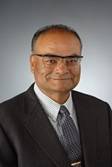报告题目:Generation of Non-Minimum Phase Response of Electromagnetic Systems Using Amplitude only Data
报告人:IEEE Life Fellow,Prof. Tapan K. Sarkar
报告时间:2019年6月15日9:45-10:20
报告地点:西安市高新四路蓝溪国际酒店群贤厅
报告摘要:
The objective of this paper is to illustrate how to generate the nonminimum phase response of an electromagnetic system from amplitude only data. It is important to note that the phase reconstruction from amplitude only data yields a nonunique solution as a linear phase term can be added to the system response without distorting its amplitude response since the linear phase term only adds a delay.
Reconstruction of phase from amplitude-only data is an important problem. For minimum phase systems, the reconstructionofphase from amplitude-only data is relatively straight forward as the phase response is given by the Hilbert transform of the log of the magnitude (termed cepstrum) of the amplitude. If the system is not minimum phase (i.e., when some of the zeros of the transfer function may be on the right half-plane), then the above integral relationship does not hold. Most electromagnetic systems have a nonminimum phase response. Hence, this methodology developed for acoustic systems where almost all systems are minimum phase have very little use for the practical electromagnetic problems. However, there is a more general result of the Hilbert transform, which is based on causality. This latter result is valid for any nonminimum phase system. We utilize the principle of causality to carry out a nonminimum phase realizations. The principle of causality implies that the functionf(t) = 0 fort< 0, and is nonzero otherwise. It is important at the onset to point out that the phase realization (be it minimum or nonminimum phase) is not a unique problem. A linear-phase term may be added to any phase function without altering its amplitude spectrum. This is because the addition of a linear phase to the phase of the transfer function with a uniform amplitude is equivalent to a pure delay in the time domain. Since we are dealing with linear-shift invariant systems (as the response of the system is the same independent of the time origin), changing the impulse response of the system by a time shift does not alter the transfer function of the original system, except that the phase spectrum is modified by a linear-phase function. The slope of this linear-phase function is equivalent to the time delay. Also, the amplitude spectrum of the transfer function is unaltered by providing a delay to the impulse response of the system at hand.
报告人简介:

Tapan K. Sarkarreceived the B.Tech. degree from the Indian Institute of Technology, Kharagpur, in 1969, the M.Sc.E. degree from the University of New Brunswick, Fredericton, NB, Canada, in 1971, and the M.S. and Ph.D. degrees from Syracuse University, Syracuse, NY, in 1975. From 1975 to 1976, he was with the TACO Division of the General Instruments Corporation. He was with the Rochester Institute of Technology, Rochester, NY, from 1976 to 1985. He was a Research Fellow at the Gordon McKay Laboratory, Harvard University, Cambridge, MA, from 1977 to 1978. He is now a Professor in the Department of Electrical and Computer Engineering, Syracuse University. His current research interests deal with numerical solutions of operator equations arising in electromagnetics and signal processing with application to system design. He obtained one of the “best solution” awards in May 1977 at the Rome Air Development Center (RADC) Spectral Estimation Workshop. He received the Best Paper Award of the IEEE Transactions on Electromagnetic Compatibility in 1979 and in the 1997 National Radar Conference. He has authored or coauthored more than 360 journal articles and numerous conference papers and 32 chapters in books and fifteen books.
Dr. Sarkar is a Registered Professional Engineer in the State of New York. He is on the editorial board of Journal of Electromagnetic Waves and Applications and Microwave and Optical Technology Letters. He is a member of the International Conference Technical Committee of IEEE Microwave Theory and Techniques Society # 1 on Field Theory and Guided Waves. He was the 2014 President of the IEEE Antennas and Propagation Society.


